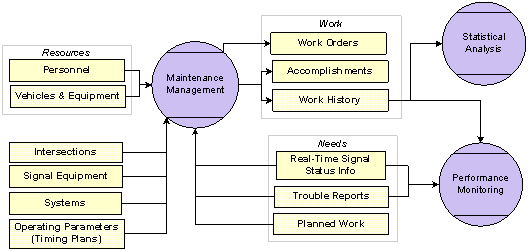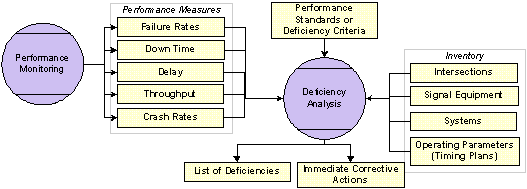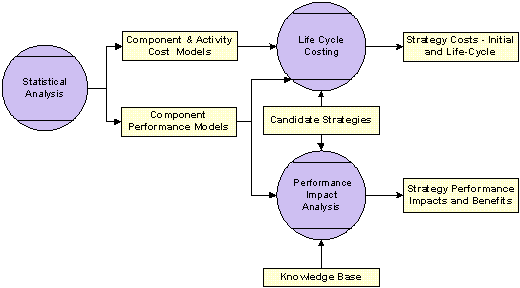At its heart, asset management is about making best possible use of available resources to implement the most effective set of actions that maximize performance in a given environment, informed by quality information and analysis. The signal system model presented in Section 3.0 and the generic model in Section 4.0 identified:
This section focuses on the decision-making processes and explores how information and analysis tools can be used to support and improve them.
In order to define the elements of a signal system asset management system, it is necessary to begin with an identification of the decision processes that the system is intended to support:
This section describes the key elements of these decision processes and their inputs and outputs. It presents high-level diagrams of the SSAMS components that would be required to support these decision processes. The SSAMS architecture is described in more detail in Section 5.3.
Key Process Elements – Staff hiring and training, work prioritization and scheduling, staff deployment, response to urgent work requests and equipment failures, adjustments to operating parameters in response to special events or incidents.
Inputs – Information about:
Outputs – Work orders, work accomplishments, changes to staff, changes to operational parameters and equipment resulting from work, updates to ongoing system performance tracking information.
Figure 5.1 shows the SSAMS components to support this process. System functions are shown as circles; data components are shown as rectangles.
Figure 5.1 SSAMS Architecture
Daily Operations and Management Process

Key Process Elements – Identify problem areas which are contributing to poor performance – for example, equipment with high failure rates, intersections with recurring operational problems, high crash locations. Prioritize deficiencies based on severity of problems, impacts on customers and other established criteria.
Inputs – Key inputs to deficiency analysis include:
Outputs – Prioritized list of deficiencies, identification of immediate actions for correction.
Figure 5.2 shows the SSAMS components to support this process.
Figure 5.2 SSAMS Architecture
Deficiency Identification Process

Key Process Elements – Development of preservation options includes specification of policies and standards for how often different types of maintenance work is to be done, and the conditions under which different types of remedial actions (repair, rehabilitate, replace) are to be taken.
Development of improvement options includes consideration of both operational improvements (e.g., signal re-timing) that can be accomplished without major capital investments, and upgrades (e.g., adding signals to the network, implementing a traffic management center, modernizing signal equipment and systems). All preservation and improvement options are analyzed with respect to life-cycle costs and likely contribution to improved performance. Life-cycle cost analysis is performed to understand the full costs of an option. These costs include initial capital costs and other implementation costs (e.g., staff training) and changes (both increases and decreases) in ongoing operational, maintenance requirements.
Inputs – Information needed for the development and evaluation of options includes:
Outputs – Candidate strategies for consideration in resource allocation, with documented initial and life cycle costs, performance impacts, and benefits.
Figure 5.3 shows the SSAMS components needed to support the development and evaluation of preservation strategies and improvement options.
Figure 5.3 SSAMS Architecture
Preservation and Improvements Options Evaluation Process

Key Process Elements – Allocating a fixed budget across competing needs, making best use of available funding sources. Selecting the best mix of preservation and improvement work and associated investment in physical equipment maintenance/replacement, system refinement/upgrades, and personnel. Estimating resource requirements based on a set of target activities, assessing where to make cuts when funding is reduced, and where to make additions when funding is increased.
Inputs – Information needed for Resource Allocation and Budgeting includes:
Outputs – Planned work, budget request line items (including resource and cost estimates).
Figure 5.4 shows the SSAMS components required for the resource allocation and budgeting process.
Figure 5.4 SSAMS Architecture
Resource Allocation and Budgeting Process

The key business processes that a SSAMS must support were described above in Section 5.2, and Figures 5.1 to 5.4 illustrated the associated data and analysis components for these business processes. Each of these SSAMS components is described below, and then their linkages and relationships to the key business processes are discussed.
Intersection Inventory – Identification of the signal subsystems (groups of interconnected or coordinated intersections), and the physical locations of signal equipment at each intersection. May include documents (design drawings, traffic studies).
Equipment Inventory – Information about the equipment at each intersection (signal structures, signal heads, controllers, detectors).
Systems Inventory – Information about the communications and computer hardware and software deployed in the field and at the central management center (if any).
Personnel – Information about the personnel resources available to perform signal maintenance and operations tasks.
Vehicles and Equipment Inventory – Information about the vehicle fleet and equipment resources available to perform signal maintenance and operations tasks.
Operating Parameters – Information about the current timing plans in effect.
Work Orders – Scheduled work activities including location/component identification, resource assignments, and status.
Accomplishments – Completed work activities, summarized for performance tracking purposes.
Work History – Historical information about signal work completed – description of actions taken, components repaired and replaced, and resources utilized.
Real-Time Signal Status Information – Real-time information available from signal system management software on the operational status of different system components.
Trouble Reports – Historical information on trouble tickets including location/equipment involved, nature of problem, resolution, and response time.
Planned Work – List of planned and approved work activities to be scheduled.
Performance Measures – Measures of systemwide, corridor, intersection, and component-level performance, including equipment failure rates, signal down-time, traveler delay, throughput, and crash rates.
Performance Standards or Deficiency Criteria – Target or threshold levels of performance measures used to identify where deficiencies exist.
List of Deficiencies – List of intersections, signals or signal system components that should be considered for remedial actions in order to improve performance.
Candidate Strategies – Includes both candidate preservation and improvement strategies. Preservation strategies seek to preserve the original functionality of existing signal system components and are defined by maintenance, repair, rehabilitation, and replacement cycles. Improvement strategies include operational improvements such as signal retiming, upgrades to the system (e.g., implementing new controllers or system control software), and expansion of the system (e.g., connecting additional intersections).
Component and Activity Cost Models – Default signal system component repair, rehabilitation, and replacement costs needed for life-cycle cost analysis. These may be built up from models of standard resource requirements for different types of maintenance and repair activities and resource unit costs.
Component Performance Models – Default signal system component performance models specifying key parameters such as average life, mean time between failures, condition, or failure/malfunction rates at different ages.
Strategy Initial and Life-Cycle Costs – Estimated costs of a given preservation or improvement strategy – both initial and continuing costs over the component life cycle, typically broken down by cost component.
Strategy Performance Impacts and Benefits – Estimated performance impacts and benefits of a candidate preservation or improvement strategy– both initial and recurring.
Knowledge Base – Compendium of documents and data sets with support information on equipment specifications, activity costs, component life, research reports, etc.
Funding/Budget Authority – Information on available budget authority by category.
Budget Requests – Budget line item descriptions and costs.
Project Cost Estimates – Engineering estimates of capital projects for budgeting purposes. These may be different from the cost estimates that are derived from Life-Cycle Cost Analysis.
Maintenance Management – Produce work orders, schedule resources and equipment, maintain repair records, record resource utilization.
Statistical Analysis – Conduct analysis of historical repair record data to derive estimates of component life, failure rates, repair costs by age, etc.
Performance Monitoring – Provide periodic snapshots, summaries or real-time reporting of performance data used by managers and operational staff to identify needs and prioritize activities.
Deficiency Analysis – Identify deficiencies for signal system components, intersections, and/or subsystems based on established criteria.
Life-Cycle Cost Analysis – Estimate present value of outlays for a life-cycle activity profile of construction, rehabilitation/repair, maintenance and operating costs. Standard work activity definitions and associated resource requirements support this cost analysis function.
Performance Impact Analysis – Provide analysis of the performance impacts and benefits of alternative actions.
Resource Allocation – Select the best set of candidate actions to maximize performance or benefits subject to resource constraints. Account for interrelationships among personnel, equipment, and system-related items so that resources are balanced appropriately.
Budgeting – Estimate resource requirements and costs for a set of activities in support of budget development.
While not explicitly shown in the SSAMS architecture, a Query and Reporting capability is required as an integral part of all of the functional components.
The SSAMS functional components defined above assist signal system management and operations personnel to make strategic, tactical, and operational decisions. They are not intended to fully automate decision-making, just to provide better information and analysis tools to support it.
Daily Operations and Management Process – Three SSAMS functions were identified for use within the day-to-day operations and management process: Maintenance Management, Performance Monitoring, and Statistical Analysis. Maintenance Management takes information about available resources (personnel, vehicles, and equipment), and schedules work activities. Needs for work are generated from planned work, trouble reports and (if available), real-time information from the signal system itself. Information about the work that is done, age/condition of the signal inventory components that were worked on, and resources consumed is recorded by the Maintenance Management function. This information feeds into a Statistical Analysis function that supports business processes for evaluation of preservation and improvement strategies. Real-time status information and information on resolution of trouble reports used for Maintenance Management also feeds into the Performance Monitoring function, which is used to identify and target deficiencies.
Deficiency Identification Process – The Deficiency Analysis function takes information from the Performance Monitoring function, and provides a systematic capability to identify locations/components meeting user-specified criteria (e.g., high crash rates, high failure rates, older style equipment, etc.). Inventory information is integral to this process, providing capabilities to analyze deficiencies by intersection, corridor, or subsystem.
Development and Evaluation of Preservation and Improvement Options Process – This process involves development and evaluation of system preservation, operational improvement, upgrade and expansion options for addressing the identified deficiencies, and maintaining signal equipment and systems in a cost-effective manner from a life-cycle perspective. For preservation options, the Life-Cycle Costing Analysis capability is used to evaluate candidate life-cycle activity profiles (maintenance, rehabilitation, and replacement) for different components. For improvement options, Life-Cycle Costing Analysis is used to get an understanding not only of the initial capital costs of these improvements, but also the full costs throughout the life, ensuring that maintenance and operational implications of new systems and equipment are considered. The Performance Impact Analysis capability yields estimates of the impacts of different preservation and improvement options on physical condition and operational performance of the signal system over time. It also produces estimates of benefits to system users (e.g., reduced delay) and managers (e.g., reduced maintenance costs). This may be provided at a “sketch-planning level,” or may incorporate more detailed simulation modeling techniques. The Impact Analysis capability is also supported via queries of the Knowledge Base. Together, life-cycle cost and performance impact analysis provide the information needed to compare and contrast preservation and improvement strategies – how they will impact performance, and what each will cost over its life cycle. This information can be used for tradeoff analysis across different investment options.
Resource Allocation and Budgeting Process – This work process includes a resource allocation function to systematically evaluate different work mixes and determine how to make the best use of limited resources, and a budgeting function that assists with the development of budget line items given a chosen mix of work. The resource allocation function uses information on benefits and costs of alternative preservation and improvement strategies produced by the Life-Cycle Costing and Performance Impact Analysis functions. The budgeting function uses information on existing resources and work history to support development of trend-based estimates of resource requirements. It also makes use of a costing capability to support development of budget line items associated with specific planned work activities.
Specific data components in the SSAMS architecture have been defined to describe characteristics of the three key aspects of signal systems asset management – physical equipment, systems, and personnel. The functional components of the SSAMS ensure that the key relationships among equipment, systems, and personnel are considered so that appropriate tradeoffs can be made. For example:
The components of a Signal System Asset Management System defined above can vary in scope and sophistication depending on agency size and signal system characteristics. Given the varied nature of required decision support functions, and the types of systems that may already in place – for maintenance management, budgeting, signal control, and simulation/optimization, the SSAMS is not envisioned as a new monolithic system but rather as a set of capabilities provided by a variety of tools in an integrated fashion.
In order to provide a concrete illustration of how the SSAMS decision support capabilities would be used, the next section presents an analysis of signal management and improvement scenarios, involving tradeoffs across physical, system, and personnel elements of signal systems.
Table of Contents | List of Tables | List of Figures | Top of Section | Previous Section | Next Section | HOME